Got in a very nice run today with Ashley, going 2.46 miles in (despite what the image says) 33:41. Ashley was a Very Good Dog on the run, despite just a little bit of grabbing the leash in her jaws after we turned back toward home. 🐕 🏃🏻♂️
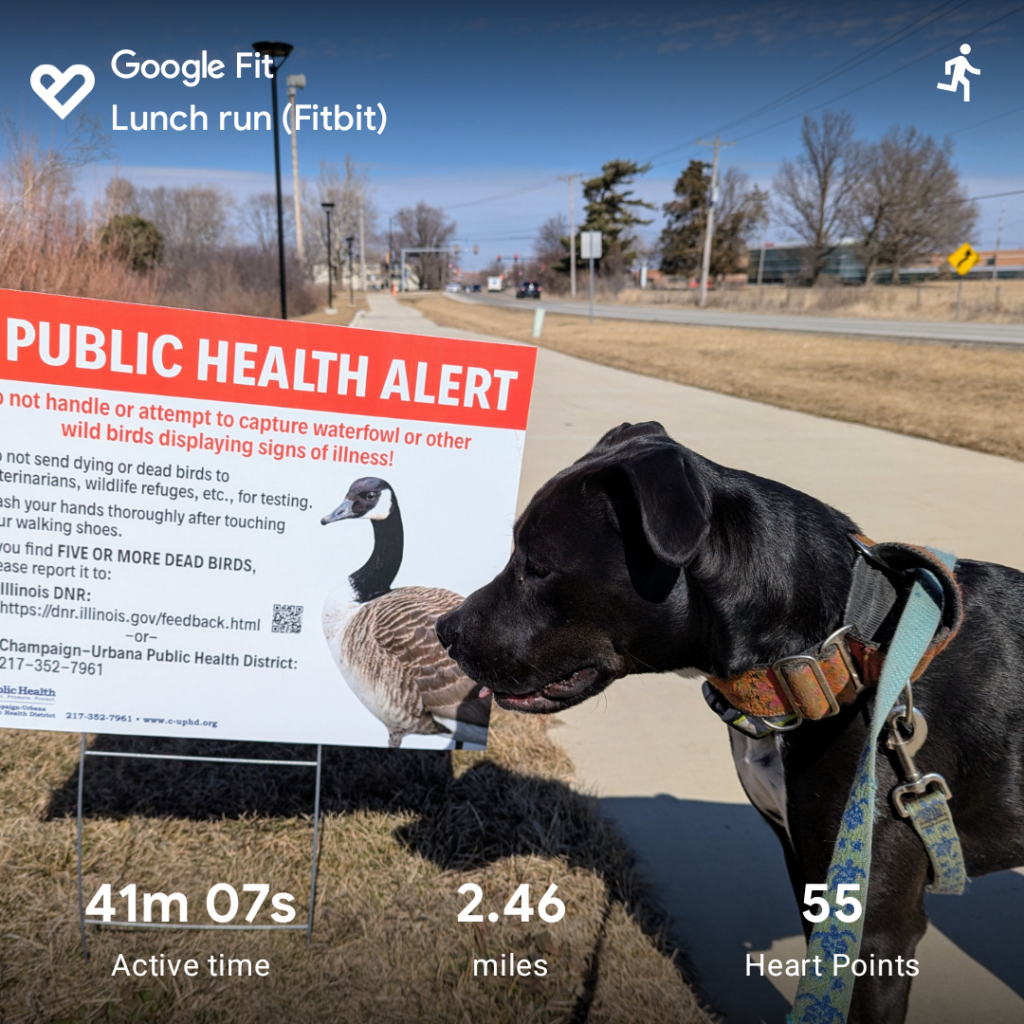

For most of my adult life, trying to use “intuition” to decide on rest days would have been a terrible idea. If I’d let myself say, “Hmm. I don’t really feel like a workout today,” I’d scarcely have worked out at all. Instead, I came up with a schedule, and stuck to it, either well or poorly.
When I stuck to it well, I’d see progress. When I stuck to it poorly, I wouldn’t.
Starting around 5 years ago or so, something changed in my brain: I started really enjoying my workouts.
Partially, it was that they were working well, which is just satisfying. But it was more than that. First, I noticed that I felt better after a workout. Then I started feeling better during a workout. Instead of it being hard to motivate myself to work out, I craved workouts.
People who knew me were mildly disturbed by this. It was unlike me. It was certainly unlike them. I would not be surprised if they began to suspect that I was some sort of pod-person.
Because I wanted to work out nearly every day, I would sometimes wonder if I was over-training (or under-recovering), but that’s not trivially easy to determine in the moment.
I’ve long tracked my workouts, but not really in a consistent way—I’d just write down what I did that day. Sometimes I could look back and say, “Wow. That looks like a serious workout,” and other times I’d look back and say, “Was that really a workout?” But often times it wasn’t clear either way.
Just lately though, I’ve been doing the Mark Wildman workout programs that I mentioned a few weeks ago. That gives me a pretty consistent metric. I’m doing three different programs, each of which has 4 to 7 different levels, each of which can be done with an almost infinite range of weights, but they all have a consistency in design: start with a light weight, work up in complexity, then bump up the weight but go back down in complexity. If you’re consciously attempting to make progress, then it’s pretty easy to make each workout “count” as a workout, while avoiding overdoing it in any particular workout.
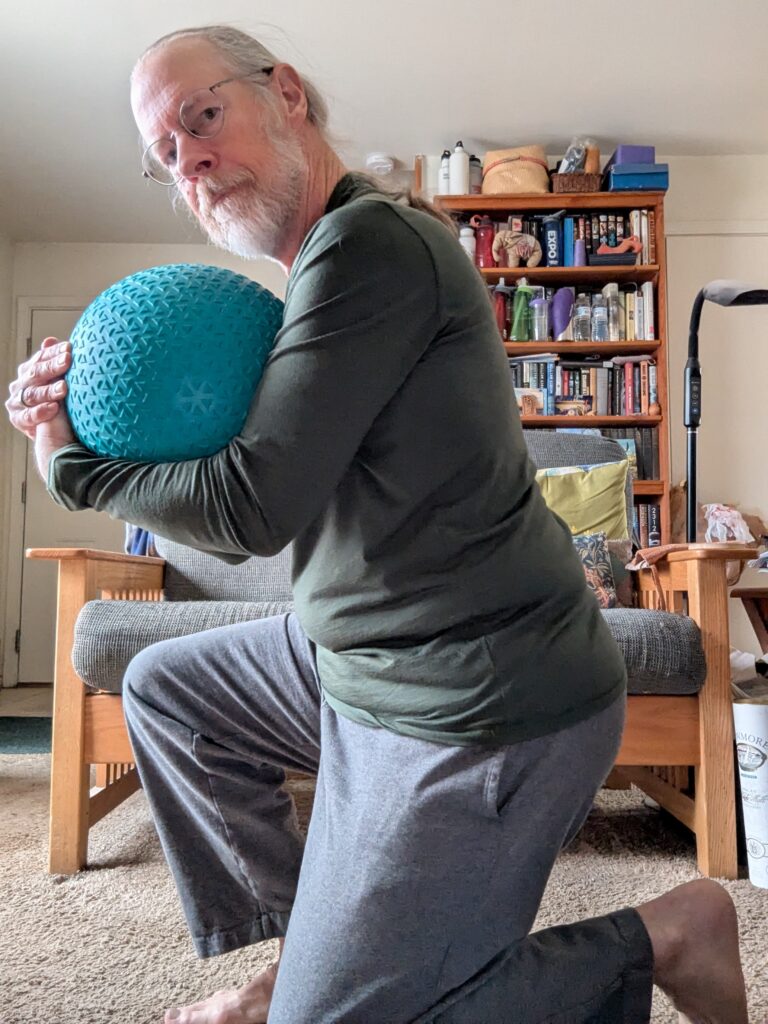
But while avoiding overdoing it in any particular workout is good, it is possible to do that, and yet get over-trained, simply by doing too many workouts with inadequate recovery.
So, today I went back over my past 3 months’ training log entries. For my first cut at this, I’m just counting rest days. I figure that I want to work out either 5 or 6 days a week, which makes any week where I have either 1 or 2 rest days a “good” week.
In the past 13 weeks I’ve had 1 week with 0 rest days, 1 week with 3 rest days, and 1 week with 4 rest days. All the rest were “good” weeks with either 1 or 2 rest days.
That’s just about perfect. The usual advice is to take a “deload” week every 4 to 6 weeks, so 2 weeks out of 13 being weeks with extra rest just about hits the nail on the head. The one week with 0 rest days was probably just an artifact of rest days falling outside of one calendar week—not a big deal, as long as it’s rare.
Anyway, the intuitive rest days seem to be working well. I’m getting in my workouts, and I’m getting in adequate rest. I guess I can stick with it for a while.
Zone-2 cardio has been having its moment. That comes from a lot of sources, but unfortunately a big one is Peter Attia. I say “unfortunately,” because Attia seems to have a weird, compulsive sense that zone-2 cardio work needs to be, I don’t know, pure in some way, rather than just being enough to promote good metabolic health.
Attia suggests that you do your zone-2 work on a treadmill, stationary bike, or rowing machine, so you can be in control of your effort level at all times. Then you can just get into zone 2 and stay there for 45 minutes.
I think this is crazy, and not just because 45 minutes of steady-state activity on a treadmill or stationary bike would be excruciatingly boring.
I do my zone-2 cardio with a mixture of walking my dog, running, and occasional hikes. Walking the dog isn’t perfect, because the dog keeps stopping to get in her sniffies, and no doubt my heart rate drops out of zone 2. Running isn’t great, because my heart rate probably spends a lot of time in zone 3 or zone 4. A lot of it is zone-2—at least, I can talk while I run, which is one of the tests for zone-2. (I run very slowly.) The hikes are probably perfect zone-2 cardio, but are a big time commitment in a single day.
Attia suggests that you optimize your cardio workouts by getting 3 hours a week of zone-2 cardio, which can optionally be divided into 4 45-minute workouts. And I’m sure that’s fine. But I suspect that getting in a couple of runs a week, along with a good bit of dog walking, is going to check the zone-2 cardio box no problem.
My theory (and I am not an MD, nor even a PhD in exercise physiology, but still) is that this is fine. You don’t need to get 45 minutes of pure zone-2 cardio to be metabolically healthy.
As I see it, the test for whether you’re getting enough zone-2 cardio is whether or not you can engage in a moderate level of exercise for an extended period—a 3-hour hike, let’s say. If you’re metabolically healthy you can go on and on at a moderate pace, because you’re doing it almost entirely aerobically.
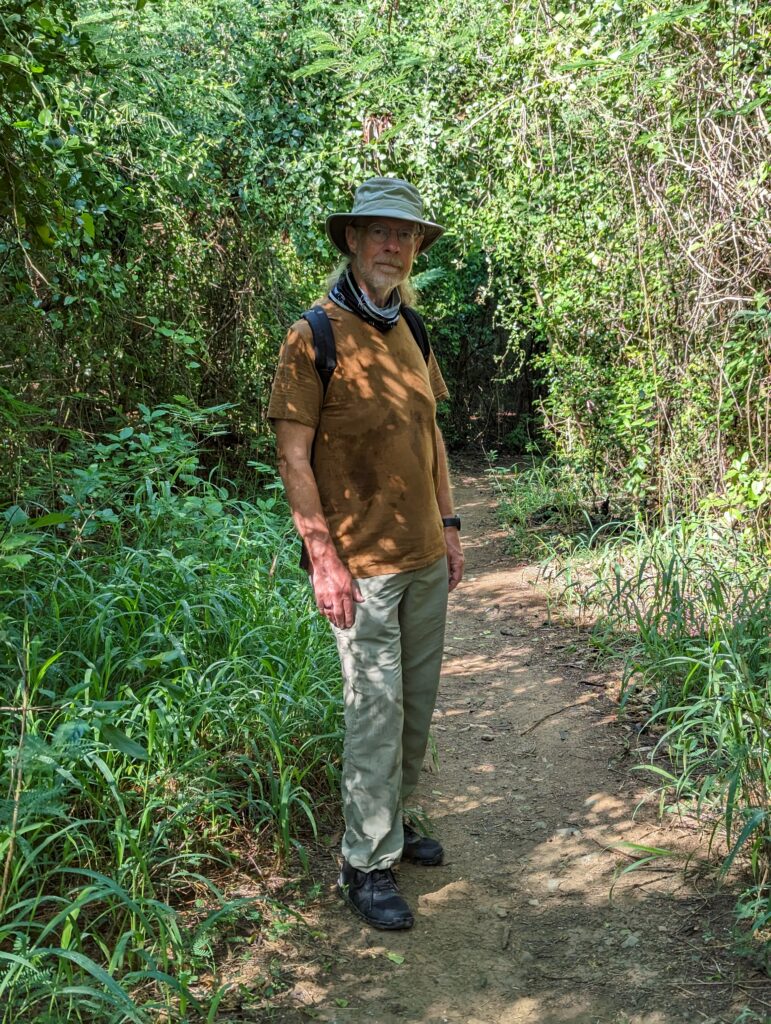
If you can do that, you’re getting enough zone-2 cardio, regardless of whether your sessions are 45 minutes long, and regardless of whether they add up to 3 hours a week. If you’re not metabolically healthy, even going at a moderate pace is going to push you into anaerobic metabolism, which will quickly become impossible to maintain.
It probably is true that you need to get in 3 hours a week if you’re going to be able to go on long, long hikes. But the idea that they need to be pure zone-2 sessions, rather than mixed sessions at all different levels of intensity, is just crazy.
About a decade ago, thanks especially to finding the work of Katy Bowman, but also from taking an interest in parkour and similar disciplines, I came to realize that movement was a better model for healthy activity than exercise.
Then came the pandemic.
For a lot of reasons—in particular, the loss of the opportunity for moving with a community—I found that returning to exercise suited me better, especially in the early days of the pandemic. (Follow that link for a pretty good post about where training falls on the movement vs. exercise spectrum.)
Over the past year I realized that it’s been five years now that I’ve prioritized exercise over movement, despite the fact that I still think that movement is the better choice. But when I started thinking that I should start trying to emphasize movement more again, I realized I already have been.
The biggest way that movement has snuck back into my practice is HEMA (aka sword fighting). There is some exercise involved in training for sword fighting, and it is certainly not a complete healthy movement practice all on its own, but it is moving, for a purpose, with a community—things I had been lacking for years.
The next biggest has been walking. In particular, dog walking. It’s not that walking has snuck back into my practice. I have always been a walker, and all that getting a dog changed was that now I walk every single day, instead of merely almost every day. (Even during bad weather, I average at least 12,000 steps per day. When the weather is nice, I top 15,000.) What having a dog changes is that now the walking is not exercise. It’s movement, because I’m doing it for a purpose that has nothing to do with “getting some exercise,” and rather is about making sure my dog is getting what she needs.
I still do some exercise. In particular, I’ve paid up for four workout programs by Mark Wildman: His two club programs two-handed and one-handed, his slamball program, and his “actual action hero” ab program. I skipped getting a kettlebell program (I’ve been doing kettlebells long enough that I feel like I know how to integrate them into a fitness routine, plus my sore elbow seems to be aggravated more by kettlebell moves than by club or slamball moves.)
I’m really pleased with the two-handed club program, which adds to the basic swinging moves a set of lunge moves, a set of squat moves, and a set of ab moves (that work toward a get-up).
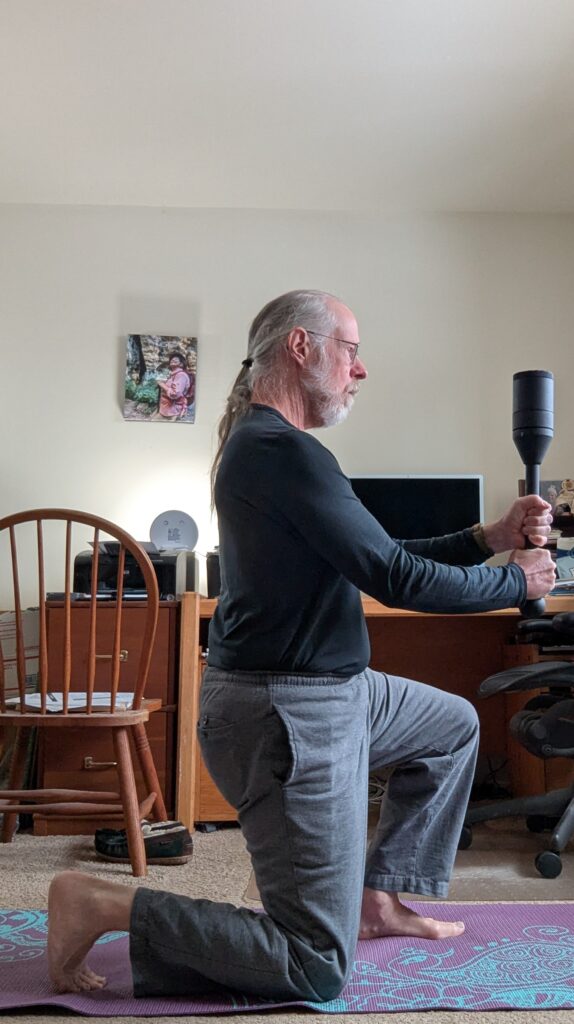
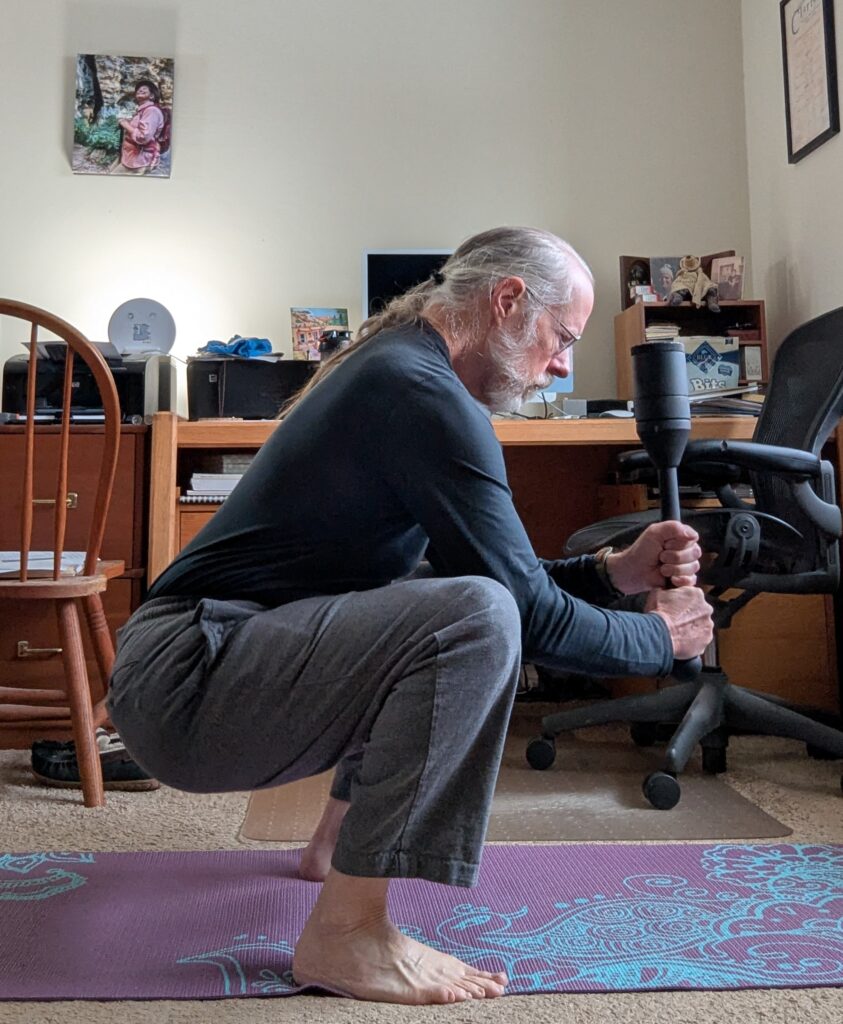
The one-handed club program is also good, but much more technical and specific. It’s purpose, I guess, is to improve your alignment and structure, which is cool (and which I expect will be useful for sword fighting), but it doesn’t look like it’s going to do a lot for overall fitness.
The ab program is interesting. Mark Wildman wrote it for his friends who are stunt people, who needed a program that could be done in a very small space (basically a yoga mat on the floor of a trailer, which is what stunt people live in on-set), that focused not on making your abs look good (although it definitely will) but rather on building the muscle, strength, and control to do the sorts of moves that stunt people need to do. It’s designed to be done in just a few minutes every day at the end of your usual workout. It has 50 moves, and it gives you a different combination of them every day for up to a year (assuming you can work up to doing continuous ab work for 14 minutes a day, five days a week.
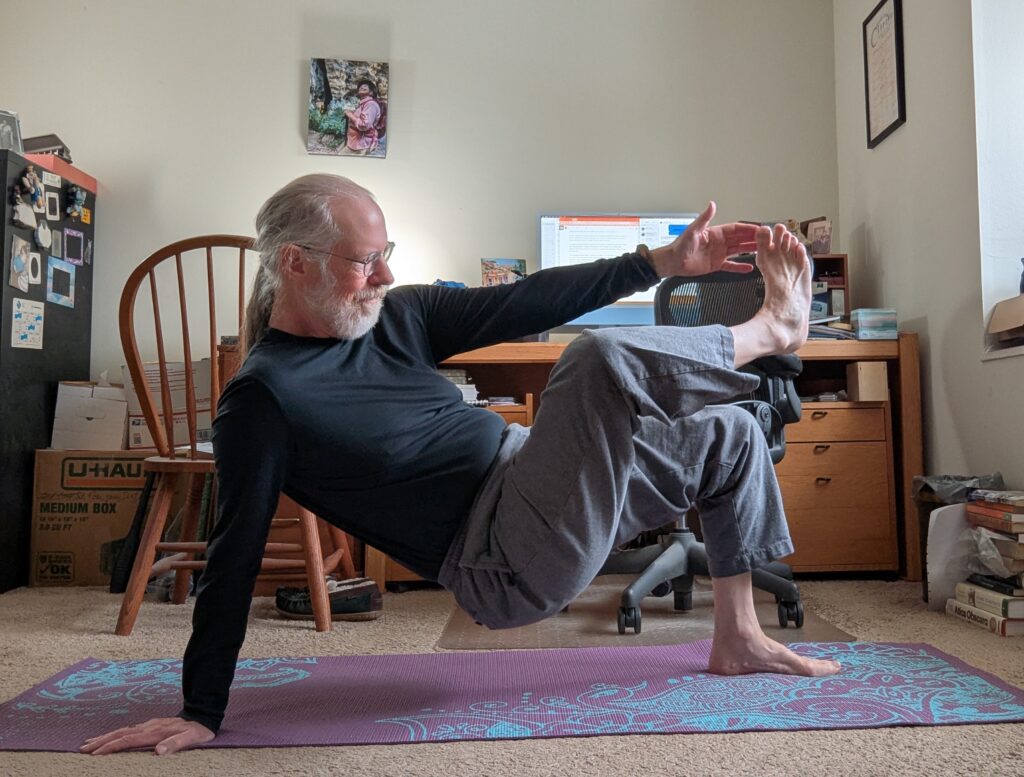
So, I do continue to exercise, because it seems useful, and it suits me, but I’m going to resume trying to prioritize movement going forward.
I’ve scarcely fenced with the students since the groups split a year ago. It was made clear that I was welcome to come train with the student group, but most of the training sessions were the same time as my group was meeting, and anyway my shoulder and elbow issues meant I had to reduce the amount of training I was doing, so I ended up training with my own group.
That changed this week when the student group had a “fancy-dress fechtschule,” and invited the TMHF members to join in.
A fechtschule (which just means “fight school”) is a particular kind of contest where the point is not so much to “win” (although you want to do that too), as it is to display artful fencing. To encourage that the rules call for only head hits to count, and prohibit things like thrusting (too likely kill your opponent), grappling, pommel strikes, etc.
Because only head hits count, it seemed reasonably safe to wear just masks and not full protective gear, enabling a fancy-dress version, which seemed to me like great fun. Many of the women showed up in dresses or gowns of one sort or another (some in heels!). Many of the men wore suits. I wore a coat and tie.
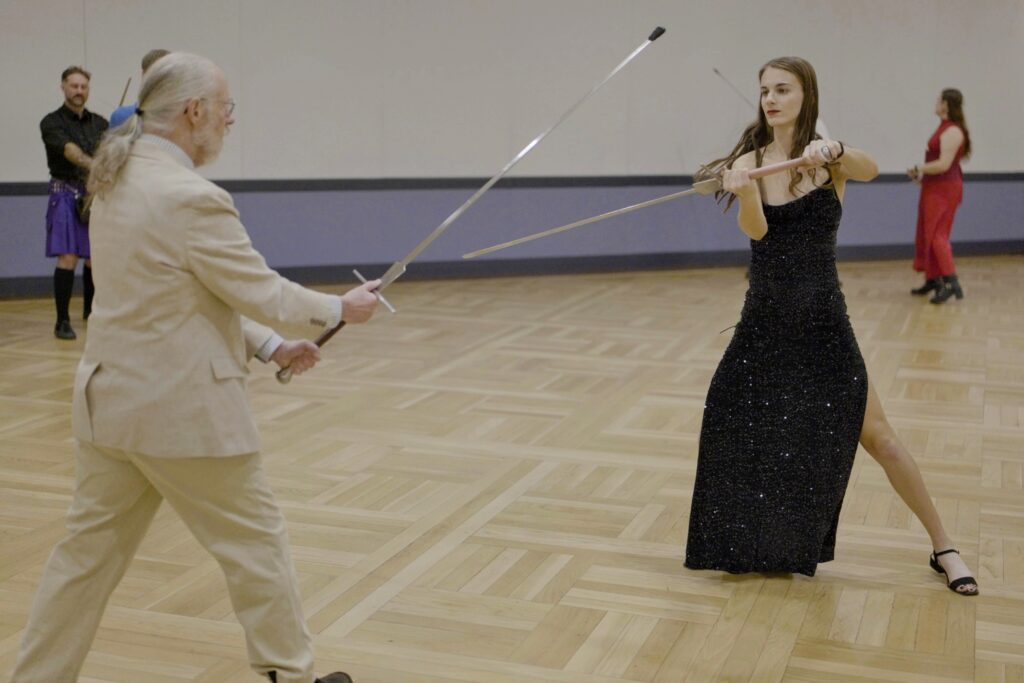
The call for attending was simply to wear “the most formal thing you own that you are willing to fight in.”
After a youth during which I couldn’t imagine “dressing up” any more than absolutely necessary, somewhere along the line I figured out a few things, one of which was that men’s dress clothing is actually more comfortable than casual clothing, because it is altered to fit well, rather than just being “the right size.” These days besides wearing dress clothing whenever it will give me an advantage, I also wear it anytime it seems like fun. (While traveling—on a plane or a train, and while in a station or an airport—you get much better service if you’re wearing a coat and tie than if you’re wearing shorts or sweats.)
There was a great deal of artful fencing.
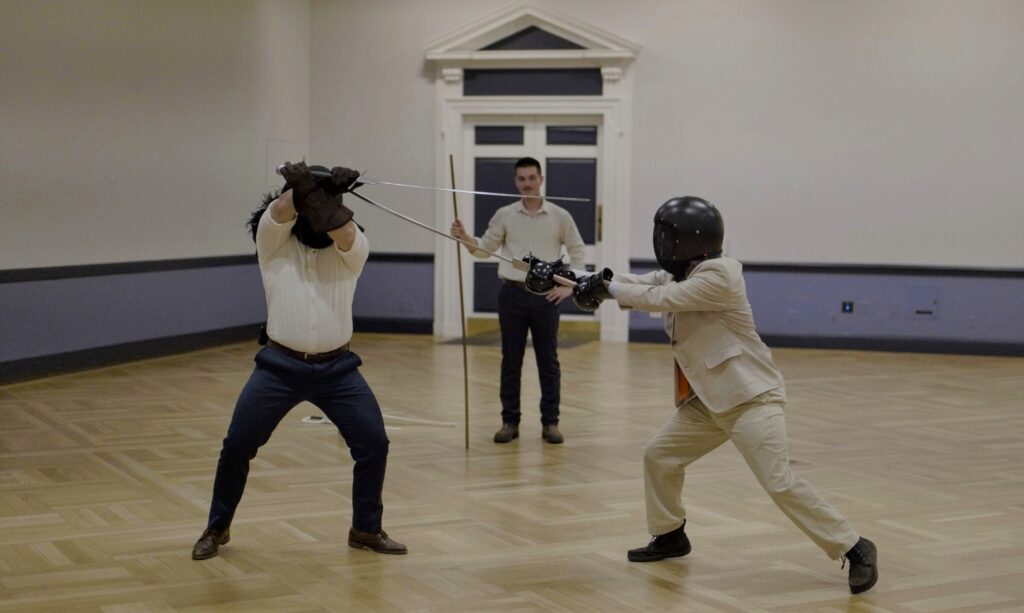
It has taken most of three years, but I’m finally doing a pretty good job of keeping my arms extended while doing longsword. (Partly I just needed to develop the habit, but I also needed to build strength and endurance in that arms-extended posture.)
It was glorious fun. I even did okay in the contest. (I think Milosh went easy on me.)
I do need more work on fencing artfully.
Just before my summer trip to Amherst, I got a Covid booster—even though the new Covid shot was just about to come out—because I wanted to minimize the chance of catching Covid on a plane or at an airport, and bringing it to my mom or brother.
Since then, I’ve been waiting for four months to pass, so I could get the new shot, now that it’s available. (It turns out that now you only have to wait two months, but nobody told me that.) Anyway, the four months are up, so I got my Covid booster and a flu shot this morning.

My left arm is now moderately sore. In fact, it roughly matches my right arm, which has been sore for months now. (I think originally dog-walking injuries to my right elbow and right shoulder, exacerbated by sword fighting, and exercise. I’ve recently started walking the dog left-handed, cut my sword fighting practice to just once a week, and cut the weight way down on my kettlebell clean&press. Oh, and I have a modest bruise on the right bicep where yesterday I took thrust that just missed the protective plate on my fencing jacket. The jacket is also padded though, and the thrust wasn’t that hard, and the sword was nicely flexible to make it safe for sparring between friends.)
“Mounjaro and the weight loss drug Zepbound slashed by 94 percent the risk that overweight or obese adults with pre-diabetes would develop diabetes… a lot of those same people could have had a great outcome with lifestyle intervention”
Source: NYT
Great outcomes from lifestyle interventions are why almost nobody in the US has diabetes.
For much of my life I thought that the key to losing weight was just exercising more. Especially in the mid-1980s, when I lived in Utah and California, I’d get out for some long hikes in the mountains and deserts and think, “If I could just do this all the time, it would be easy to maintain a proper weight.” That turns out to be both true and false.
The fitness influencer types like to say things along the lines of “You can’t outrun your fork,” meaning that you simply can’t burn enough calories to get ahead of eating way too much. I knew that wasn’t completely true. Read about any long-distance endurance athlete (ultra-marathoner, Tour de France rider, etc.) and you’ll have a window into really extreme efforts to eat enough just to keep going, let alone enough to recover for the next day’s effort.
I also have a slightly more ordinary example. A couple of guys I knew tried to bicycle around Lake Superior and Lake Michigan, and had to abandon the effort halfway through, because their riding (100+ miles per day) burned so many calories (perhaps 5000 calories on top of their basal metabolic rate, so maybe 7500 calories per day total), they ran out of money for food.
It’s tough to eat 7500 calories per day even without the financial limit, so it seems like, if you have all day to do nothing but exercise, and the will to exercise hard for several hours a day, perhaps you could “outrun your fork.”
Recent research shows that this is not the case, except in the very short term. People who are very active all day, like hunter-gatherers (but also subsistence farmers, and laborers of other sorts), burn more calories than people who are sedentary all day, but only modestly more.
A recent study showed that among of Hadza people, activity was almost insignificant as a predictor of total energy expenditure. They were remarkably active, but their calorie consumption was pretty ordinary. The study suggests that body size is just about all that matters
In that study, average total energy expenditure among Hadza men was 2649 calories per day. The average is higher among western men, but only because their body size is greater. (Hadza men averaged 50.9 kg (112 lbs), while Western men averaged 81.0 kg (179 lbs). Differences in BMI are more stark, with Hadza men having a BMI averaging 20.3, while Western men’s BMIs averaged 25.6.)
The point here is that it seems like your biology is attuned to wanting to eat 2600 calories and wanting to burn 2600 calories. (Adjust for frame size. It seems the Hadza men averaged about 5′ 2″.) You can be sedentary, under-eat to match, and not gain weight, but it’s not in tune with what your body wants, so you’ll be hungry all the time, as well as having all the side-effects of under-movement.
You can also try to exercise enough to burn more than 2600 calories, but it seems that as soon as you go over that level, your body starts trying to compensate—turning down whatever is easy to turn down, such as your immune system, and muscle-building system.
That doesn’t happen immediately. If you go on a century ride you will burn the extra 5000 calories that simple arithmetic would suggest. That would probably continue if you went on a three-day bicycle tour. But pretty quickly—probably just in a week or so—less-essential body functions would ramp down (and of course fatigue would ramp up) bringing your total consumption back down toward 2600 calories.
You can see how this would work well for hunters. You go for a hunt one day (or two or three days), hiking or running for miles, finding prey, tracking it, and finally killing it. Then you (and your whole tribe) have lots of food to eat for a day (or two or three). During extended periods of excess activity maybe your immune system and muscle-building system ramps down, but then during periods of ample food and less activity, maybe it ramps up extra, allowing for full recovery.
Consuming more calories than you burn for more than a few days, however, quickly leads to problems. Increased fat storage is probably the least of them. Insulin resistance is another. Systemic inflammation is another. Those extra calories will go into the things that get turned down when you’re extra-active, such as the immune system. I don’t know that there’s any evidence, but an obvious possibility is that a lot of auto-immune disorders are just an immune system that never gets turned down because people are never active enough to burn more calories than they eat, if only for a day or two.
I think it’s true that you can’t out-exercise excess calorie consumption. However, you can definitely under-exercise—and trying to under-eat to match that will also cause problems. Humans evolved to thrive with an ideal level of activity.
It’s also true that you don’t need to hit that particular level of activity and food consumption every day. In fact, I’m sure you’d be better off to be moderately active most days, and then very active 1–3 days a week. My long-ago dream of being able to hike 10–15 miles every day and then eat all I want turns out to be a terrible idea. Rather, you want to walk 5 or 6 miles most days, and then hike 10–15 miles just once or twice a week. (Feel free to swap in bicycling or rowing or whatever you like for the long days of vigorous activity, although you probably want to keep in the basic walking if you possibly can.)